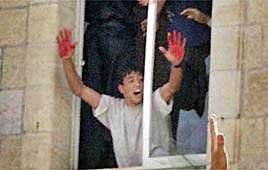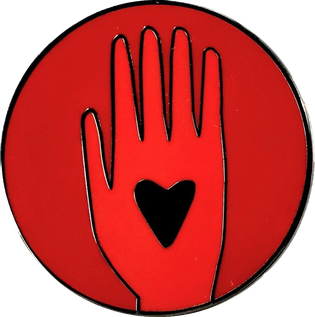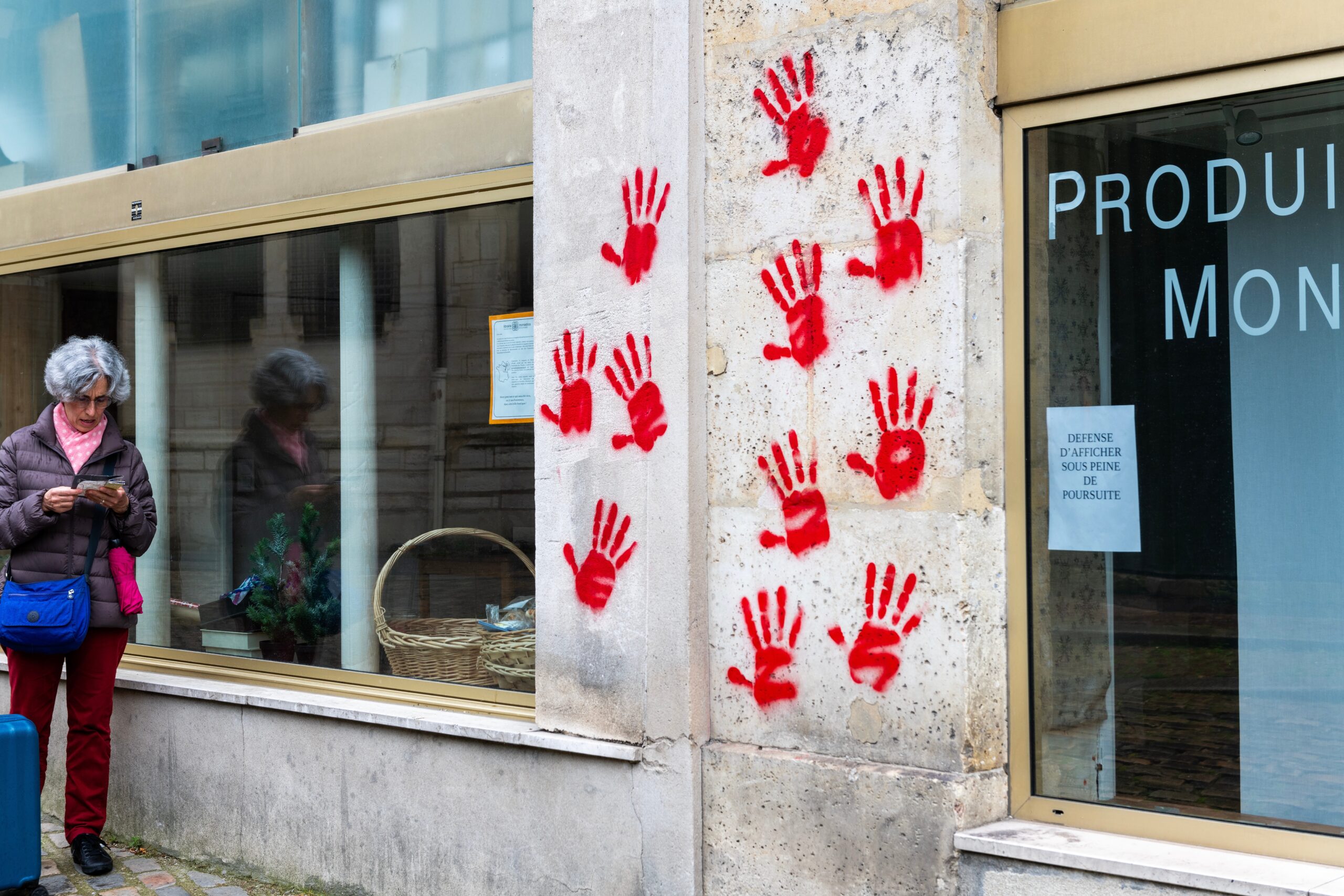In the past two years, since the October 7, 2023, Hamas attack and massacre in Israel, the red hand symbol has become ubiquitous for support for “Palestine,” from college campuses to city streets, elite Hollywood award ceremonies, and more. While ostensibly showing support FOR a cause, the symbol is one of the most vivid images of the celebration of the slaughter of Israeli Jews this century. Those who brandish it should be ashamed and shunned.
Images of red hands have adorned protest signs, lapel pins, and graffiti, used to call for a “ceasefire,” evoke claims of genocide and ethnic cleansing in Gaza, and demand the “liberation” of “Palestine” from the river to the sea, a phrase that serves as code for the eradication of Israel. Yet this symbol’s origins are inextricably tied to a vile and, for some, iconic act of Palestinian Arab violence: the October 12, 2000 lynching of two Israeli reservists in Ramallah.

By the Italian TV crew of the Mediaset channel via Wikipedia
Far from a neutral gesture of solidarity, the red hand commemorates the brutal killing of two Israeli Jews, a crime that foreshadowed the massacre of more than 1,000 Israelis during the Second Intifada, the horrors of October 7, and the many acts of terror and bloodshed that filled the years between.
While “pro-Palestine” protesters defiantly use this symbol, it catches them red-handed, exalting the slaughter of Jews.
Exactly 25 years ago this week, two Israeli Defense Forces (IDF) reservists, Yosef Avrahami and Vadim Norzhich, accidentally entered the Palestinian Arab city Ramallah, the seat of the Palestinian Authority (PA). Mistaken for infiltrators, they were arrested by PA police and taken to a local station for protection. Word of their capture spread rapidly, triggering fury among local Palestinian Arabs. A mob of hundreds stormed the station, overwhelming the complacent or, at best, inept PA police. The soldiers were dragged into the street, beaten with clubs and stones, and savagely mutilated.

One terrorist, Aziz Salha, later boasted of stabbing the victims repeatedly. As the frenzy peaked, Salha emerged from the blood-soaked scene, his hands dripping red with gore, and thrust them triumphantly outside an upper-floor window toward the cheering crowd outside. Italian television footage captured this grotesque display: Salha grinning, palms raised like a conqueror, as onlookers ululated in celebration. The soldiers’ bodies were eventually defiled further—reports described desecration as being disemboweled and with their genitals stuffed in mouths—before being handed over to Israeli forces hours later. This savagery is what the red hands truly symbolize. One might say it was the precursor to the savagery of the 2023 Hamas massacre, but historically, this behavior is not new. It literally represents the incitement of and slaughter by Palestinian Arabs against Jews for more than a century.
"Ordinary" Palestinians have a history of using their bare hands to murder Jews. Children. Babies. This isn't a one-off.
— The Mossad: Satirical and Awesome (@TheMossadIL) February 21, 2025
2000 Vadim Norzhich and Yosef Avrahami, Ramallah.
2011 Fogel family, Itamar.
2023 Bibas children, while captive in Gaza. pic.twitter.com/Ne4AeCqsWR
The Ramallah lynching shocked the world and escalated the Intifada’s brutality. Yet Palestinian Arabs celebrated it, and lionize it still today as a point of pride in their “resistance” against Israel, all part of the death cult which they worship.
Over two decades, the red hand evolved from a snapshot of horror to be condemned, into an emblem of indifference to, and an excuse for, massacring Jews. Salha was convicted in absentia and remains a fugitive. The image lingers in PA iconography. Murals in Ramallah and throughout the PA allude to it, blending it with broader terrorist motifs. Among the terrorists to be released as part of the pending deal with Hamas is a Palestinian police officer, Ra’ad Sheikh, who took part in the lynching.
Yet its contemporary resurgence stems from the Gaza war’s horrors. Post-October 2023, “pro-Palestinian” anti-Israel protest adopted red handprints to protest allegations of Israeli “genocide.” At Columbia University encampments, protesters painted red hands-on tents, signaling “blood on their hands” for complicit institutions. Red enamel lapel pins were distributed as an act of protest at the 2024 Oscars, worn by vapid “artists” brandishing their hatred of Israel and indifference to a century of Palestinian Arab incitement against Jews for a global audience to see. In London and New York, keffiyeh-clad demonstrators dipped their hands in red paint, chanting for divestment from Israel. These are just a handful of such exhibits celebrating Palestinian Arab violence.
Other incidents amplify the popular use of this symbol in a wide range of anti-Israel and antisemitic hatred, in some cases specifically targeting Jews. In April 2024, red hand graffiti appeared at Pratt Institute’s Brooklyn campus, targeting Jewish students. At Princeton, “pro-Palestine” activists dyed a fountain red, evoking not just Gaza but the lynching’s viscerality. Also in Europe, where merely the presence of Jews can trigger violence like the Ramallah lynching 25 years ago, red hands were used to vandalize Paris’s Holocaust Memorial in May 2024.

At best, adopting this symbol shows ignorance and apathy. At worst, it’s an endorsement of antisemitism, celebrating the Ramallah murders, devaluing Jewish life, and justifying any form of “resistance,” even against Israel’s right to exist.
Ultimately, the roots of the 2000 Ramallah lynching red hand and the mob’s euphoric bloodletting haunt its use today, alienating allies and entrenching divides. In an era of viral imagery, where clips of red-painted palms garner millions of views, this emblem risks perpetuating cycles of dehumanization rather than resolution. True ceasefires demand symbols that bridge, not bloody, histories—lest the hands meant to stop violence forever stain the path to peace.
It’s one thing to be “pro-Palestinian”. But when the symbols of such are inextricably linked to hatred and celebration of the massacre of Israelis, one must call into question both the genuine intent of the protesters and of the “movement” on whose behalf they are protesting to begin with. If being “pro-Palestinian” means celebrating the death of Israelis and Jews, it is void of values and legitimacy. This week, on the 25th anniversary of the slaughter of Yosef Avrahami and Vadim Norzhich, one must call out those associated with propagating, enabling, and celebrating it.




